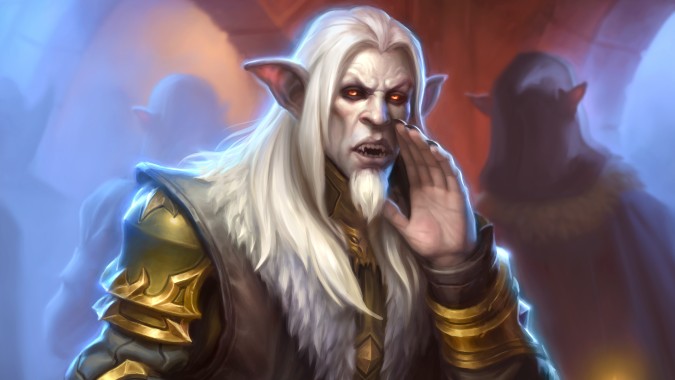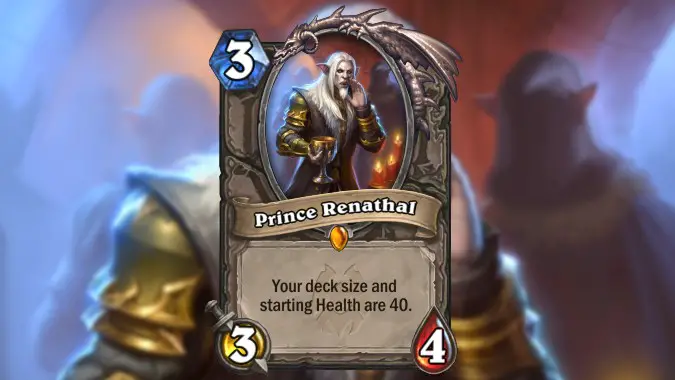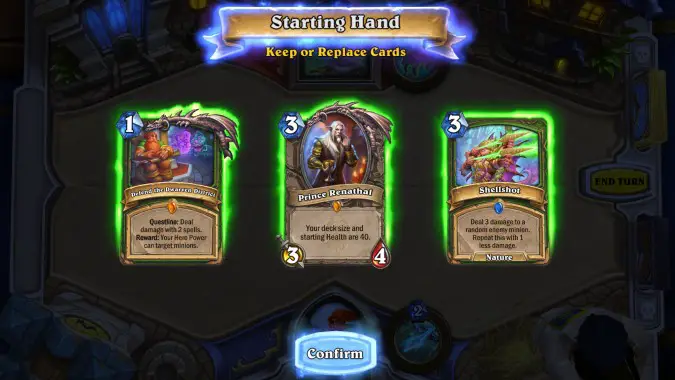What does the inclusion of Prince Renathal mean for Hearthstone?

Prince Renathal is one of the most unique cards ever made for Hearthstone. Its effect is absolutely game-changing: it lets you craft a deck that contains 40 cards, while also increasing your total health to 40. But is it worth it?
Getting 40 health is always an advantage, of course. In theory, it’s a bigger advantage to certain deck archetypes: control-oriented decks often have more ways to come back to the game later on. The longer a game takes, the more likely they are to draw cards that let them stabilize, heal themselves, and initiate a comeback. So the extra health can afford them the extra time to do just that.
But having a 40-card deck is actually a considerable drawback in terms of consistency. Drawing cards is very important in card games: you need to find your tools, and have them in hand when you need them. By adding ten extra cards to your deck, you dilute the pool considerably. There are more cards you could draw at any given time that aren’t the card you need at that moment. People have done the math and found that by going from 30 to 40 cards, you’re roughly 25% less likely to find a specific card when you need it. Sometimes not finding that key card won’t amount to much, but often enough it’ll cost you the game.
In short, having ten extra cards in your deck — or technically nine, since one of those slots is taken by Renathal himself — is only worth it if those are cards that you’re likely to use, no matter what they are, or when they come. This is why the first decks to find success with Renathal were decks that don’t care much about what the cards actually do: namely, Quest Priest and Prestor Druid.

The perfect candidates for Renathal worked well, but not well enough
Quest Priest only cares about playing cards that have the correct cost, in order to fulfill the requirements of its quest line, which are to play cards that cost specific amounts. What the cards actually do doesn’t matter too much, as long as they tick off the requirement.
Similarly, Prestor Druid transforms random cards in their deck into Dragons — so, again, what the extra cards are doesn’t matter much either, since they often won’t be used in their original forms. They’ll be turned into Dragons, and using those Dragons is how that deck wins the game.
However, although those two decks found initial success, they’re not tremendously powerful. They are viable, sure, but Renathal didn’t make them broken or overpowered. Thus some players started writing off Renathal as a “trap,” or as a card that still needs more support (from future cards) in order to shine. Until an incredibly unlikely candidate entered the scene: Quest Hunter.

Against all odds, the most unlikely candidate for Renathal worked extremely well
Initially, Hunter was actually seen as the perfect example of a class that would not work with Renathal. In general, Hunter decks are built to finish games quickly, meaning that health shouldn’t be as important a factor (since you want to end the game before you’re in any real danger). Also, every card it draws matters, since it needs to put out damage quickly — so it couldn’t afford the loss in consistency, in theory.
Reality has been very different from that. By including Renathal (and nine extra cards), Quest Hunter has been steadily rising in power, and is among the top decks in the game at the moment.
The extra ten health means that it doesn’t need to worry as much about using its spells to clear the opponent’s board — it can chuck them directly at the opponent’s face, without much fear of dying. So its game plan ended up getting even faster, and the loss in consistency didn’t hurt it as badly since players have been able to fill those extra nine slots with — you guessed it — even more damage spells, which work just fine with the deck’s game plan.
It’s a weird scenario where Prince Renathal was supposed to be a tool for control decks, but ended up finding the most success on an archetype that does the opposite of that. If I had to guess, I’d wager that this wasn’t the intent of the Hearthstone team with the card, and I wonder if they’ll address it in the future, by creating more cards that work with Renathal on its intended way — as a tool to bolster control decks — or if they’re okay with having it as a tool that works on aggressive Hunter decks more than anywhere else.
Please consider supporting our Patreon!
Join the Discussion
Blizzard Watch is a safe space for all readers. By leaving comments on this site you agree to follow our commenting and community guidelines.




